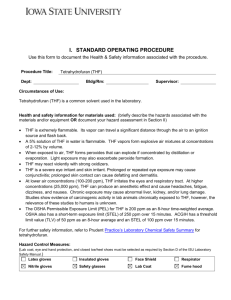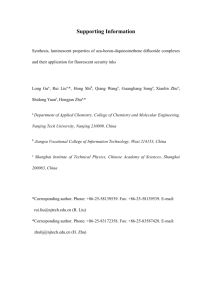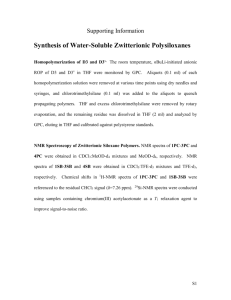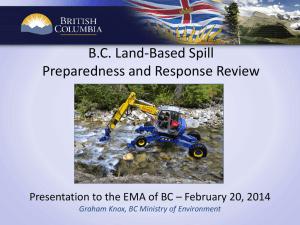Tetrahydrofuran - OSEH - University of Michigan
advertisement
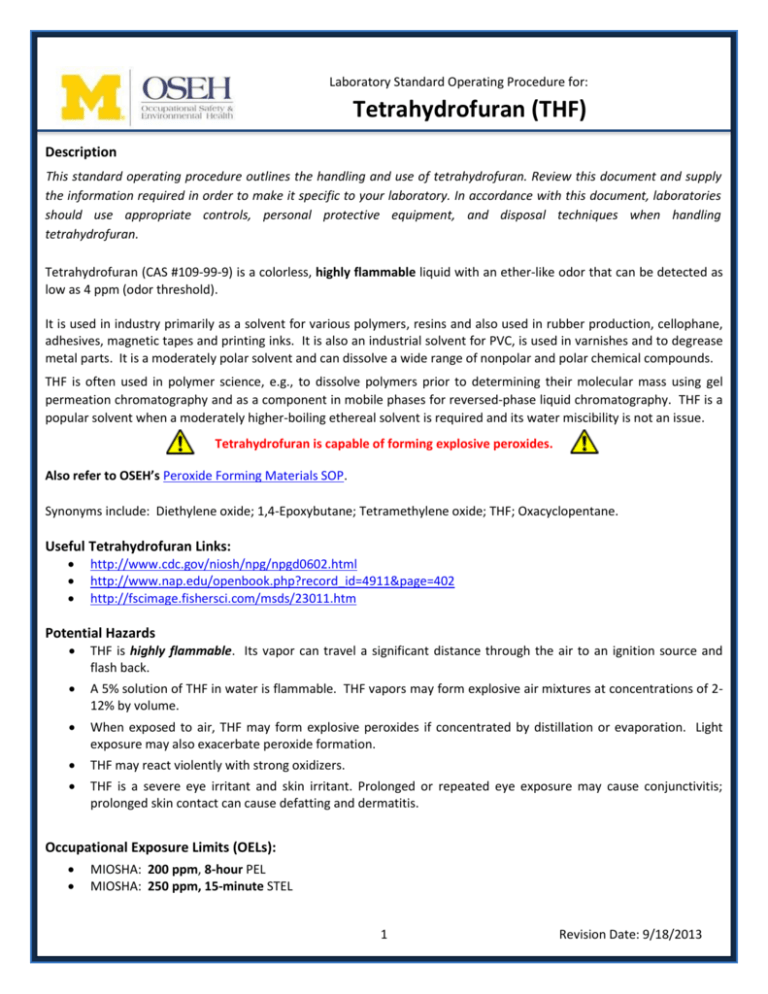
Laboratory Standard Operating Procedure for: Tetrahydrofuran (THF) Description This standard operating procedure outlines the handling and use of tetrahydrofuran. Review this document and supply the information required in order to make it specific to your laboratory. In accordance with this document, laboratories should use appropriate controls, personal protective equipment, and disposal techniques when handling tetrahydrofuran. Tetrahydrofuran (CAS #109-99-9) is a colorless, highly flammable liquid with an ether-like odor that can be detected as low as 4 ppm (odor threshold). It is used in industry primarily as a solvent for various polymers, resins and also used in rubber production, cellophane, adhesives, magnetic tapes and printing inks. It is also an industrial solvent for PVC, is used in varnishes and to degrease metal parts. It is a moderately polar solvent and can dissolve a wide range of nonpolar and polar chemical compounds. THF is often used in polymer science, e.g., to dissolve polymers prior to determining their molecular mass using gel permeation chromatography and as a component in mobile phases for reversed-phase liquid chromatography. THF is a popular solvent when a moderately higher-boiling ethereal solvent is required and its water miscibility is not an issue. Tetrahydrofuran is capable of forming explosive peroxides. Also refer to OSEH’s Peroxide Forming Materials SOP. Synonyms include: Diethylene oxide; 1,4-Epoxybutane; Tetramethylene oxide; THF; Oxacyclopentane. Useful Tetrahydrofuran Links: http://www.cdc.gov/niosh/npg/npgd0602.html http://www.nap.edu/openbook.php?record_id=4911&page=402 http://fscimage.fishersci.com/msds/23011.htm Potential Hazards THF is highly flammable. Its vapor can travel a significant distance through the air to an ignition source and flash back. A 5% solution of THF in water is flammable. THF vapors may form explosive air mixtures at concentrations of 212% by volume. When exposed to air, THF may form explosive peroxides if concentrated by distillation or evaporation. Light exposure may also exacerbate peroxide formation. THF may react violently with strong oxidizers. THF is a severe eye irritant and skin irritant. Prolonged or repeated eye exposure may cause conjunctivitis; prolonged skin contact can cause defatting and dermatitis. Occupational Exposure Limits (OELs): MIOSHA: 200 ppm, 8-hour PEL MIOSHA: 250 ppm, 15-minute STEL 1 Revision Date: 9/18/2013 Engineering Controls All work with THF should be done in a well-ventilated area. Work with large volumes or concentrated THF must be done within the fume hood. Work Practice Controls Eliminate ignition sources such as open flames, hot surfaces, steam baths, and operation of mechanical and electrical equipment that is not intrinsically safe. Keep container closed when not in use to minimize creation of flammable vapor concentrations. Ensure proper grounding and avoid creating static electricity. Be sure to ground metal containers when transferring flammable liquids. Maintain the smallest amount necessary for ongoing work. Use in the smallest practical quantities for the experiment being performed. Never open a dented or otherwise compromised container of THF. Purchase THF with inhibitors added (for peroxide-forming) when possible. Due to its peroxide-forming hazard, THF containers must be dated upon receipt and at the time they are opened. If tested, note the date it was tested. Periodically test THF containers with peroxide test strips. Do not allow to evaporate to near dryness unless absence of peroxides has been shown. Consult THF’s SDS to determine how long an opened container can be used safely, and dispose of unused amounts after that period of time has passed (or if peroxides are found to be present by testing). Know the location of the nearest fire extinguisher before beginning work. Personal Protective Equipment (PPE) In order to select the appropriate PPE for the workplace, a Hazard Assessment is conducted. The hazard assessment determines the hazards and potential hazards associated with a task, machinery, or process. The appropriate PPE for the situation may be subsequently determined. The Hazard Assessment Form may be found here. It may be completed either by the workplace supervisor or the department’s OSEH representative. Recommended gloves include Polyvinyl alcohol (PVA), Teflon, or 4H/Silver Shield brand (Norfoil). Butyl or natural rubber offer short term protection and should be removed and discarded when material is spilled on them. NOTE: THF permeates standard nitrile laboratory gloves in less than one minute and neoprene or latex in less than 2 minutes; thus, tasks should be planned to minimize glove contact with THF. If gloves become contaminated, change your gloves and wash your hands immediately to avoid skin exposure. Lab coat, long pants, closed toe shoes and safety glasses (ANSI/ISEA Z87.1 approved) for all work with THF. If a splash may occur, chemical splash goggles and/or face shield must be worn. OSEH’s Glove Compatibility webpage can also be used to determine the recommended gloves. Review THF’s SDS for more information. Transportation and Storage Transport THF in secondary containment, preferably a polyethylene or other non-reactive acid/solvent bottle carrier. THF should be stored with other flammables. Do not store THF near strong oxidizing agents, acids, bases, or organic alkali compounds. THF must be stored in an air-impermeable container and placed in a dark area to prevent further promotion of the peroxide-forming reaction. 2 Suitable fire control devices (such as fire extinguishers) must be available at locations where flammable or combustible liquids are stored. Contact UM’s Fire Extinguisher Shop at (734) 647-2059 for installation of appropriate devices. Open flames shall not be permitted in flammable or combustible liquid storage areas. Avoid storing THF on the floor. Refer to OSEH’s Chemical Storage webpage for additional information on the storage of hazardous materials. Store THF protected from moisture. Containers should be dated when opened and tested periodically for the presence of peroxides. Should crystals form in a peroxidizable liquid, peroxidation may have occurred and the product should be considered extremely dangerous. In this instance, the container should only be opened remotely by professionals. All peroxidizable substances should be stored away from heat and light and be protected from ignition sources. Waste Disposal Contact OSEH Hazardous Materials Management (HMM) at (734) 763-4568 immediately to arrange for pick-up and disposal if: 1) crystals are found around the lid of a THF container. Do NOT attempt to open the container! or 2) the container tests positive for peroxides. Most spent, unused and expired materials are considered hazardous wastes must be collected and disposed of within 90-days by OSEH-HMM. Contact OSEH-HMM at (734) 763-4568 for waste containers, labels, manifests, waste collection and for any questions regarding proper waste disposal. Also refer to OSEH’s Hazardous Waste webpage for more information. Exposures/Unintended Contact If the employee is in need of emergency medical attention, call 911 immediately. In general, flush affected eyes or skin with water for at least 15 minutes, then seek medical attention (see below). Eyes: In case of contact, immediately flush eyes with plenty of water for at least 15 minutes. Get medical aid immediately. Skin: In case of contact, flush skin with plenty of water for at least 15 minutes. Remove contaminated clothing and shoes. Get medical aid if irritation develops and persists. Wash clothing before reuse. Ingestion: If swallowed, do not induce vomiting unless directed to do so by medical personnel. Never give anything by mouth to an unconscious person. Get medical aid. Inhalation: If inhaled, remove to fresh air. If not breathing, give artificial respiration. If breathing is difficult, give oxygen. Get medical aid. If there is any doubt about the severity of the injury, seek immediate medical attention. Contact OSEH for advice on symptoms of chemical exposure, or assistance in performing an exposure assessment. 3 Report all work related accidents, injuries, illnesses or exposures to WorkConnections within 24 hours by completing and submitting the Illness and Injury Report Form. Follow the directions on the WorkConnections website Forms Instructions to obtain proper medical treatment and follow-up. Complete the OSEH Laboratory Incident and Near-Miss Report form. TREATMENT FACILITIES: U-M Occupational Health Services -- Campus Employees Mon-Fri 7:30 am - 4:30 pm After hours - go to UM Hospital Emergency Dept. – Urgent Care Clinic C380 Med Inn building 1500 East Medical Center Drive, Ann Arbor (734) 764-8021 University Health Services -- University students (non-life threatening conditions) Mon-Fri 8 am – 4:30 pm, Sat 9 am – 12 pm Contact for current hours as they may vary 207 Fletcher Street, Ann Arbor (734) 764-8320 UMHS Emergency Department -- after clinic hours or on weekends 1500 East Medical Center Drive, Ann Arbor, (734) 936-6666 For more information: http://www.oseh.umich.edu/emer-injury.shtml. Spill Procedure When a spill occurs, personal safety should always come first. Alert and clear everyone in the immediate area where the spill occurred. Use proper personal protective equipment (PPE) as noted above. Since THF is a peroxide-forming material, do not allow clean-up materials to dry; seal them inside a compatible container. A minor (small) chemical spill is one that the laboratory staff is capable of handling safely without the assistance of safety and emergency personnel, i.e., (less than 1 Gallon or 3.5 Liters). A major/large chemical spill requires active assistance from emergency personnel. Spill Response Steps: MINOR CHEMICAL SPILL Alert people in immediate area of spill. Turn off ignition and heat sources. Don’t light Bunsen burners or turn on other switches. Open outside windows, if possible. Use proper personal protective equipment as indicated above. Avoid breathing vapors from spill. Confine spill to as small an area as possible. Do not wash spill down the drain. Use appropriate spill kits/sorbents to absorb spill. Collect contaminated materials and residues and place in container. Contact OSEH-HMM (734) 763-4568 for proper disposal. Clean spill area with water. 4 MAJOR CHEMICAL SPILL Report large chemical spills (greater than 1 Gallon or 3.5 Liters) in corridors or common areas, e.g., hallways, elevators, eating areas, rest rooms, offices, etc., to UM Police Department at 911. Attend to injured or contaminated persons and remove them from exposure. Alert people in the laboratory to evacuate. Turn off ignition and heat sources. Don’t light Bunsen burners or turn on other switches. Call UMPD at 911 immediately for assistance. Close doors to affected area. Post warnings to keep people from entering the area. Have person available that has knowledge of incident and laboratory to assist emergency personnel. Additional Spill Links: www.oseh.umich.edu/pdf/chemspil.pdf http://www.oseh.umich.edu/emer-chemical.shtml. Report all emergencies, suspicious activity, injuries, spills, and fires to the University of Michigan Division of Public Safety and Security (DPSS) by calling 911 or texting 377911. Register with the University of Michigan Emergency Alert System via Wolverine Access. Training of Personnel All personnel are required to complete the General Laboratory Safety Training session (BLS025w or equivalent) via OSEH’s My LINC website. Furthermore, all personnel shall read and fully adhere to this SOP when handling tetrahydrofuran. Certification I have read and understand the above SOP. I agree to contact my Supervisor or Lab manager if I plan to modify this procedure. Name Signature UM ID # Date Prior Approval required – Is this procedure hazardous enough to warrant prior approval from the Principal Investigator? ☐ YES ☐ NO Principal Investigator Revision Date 5

